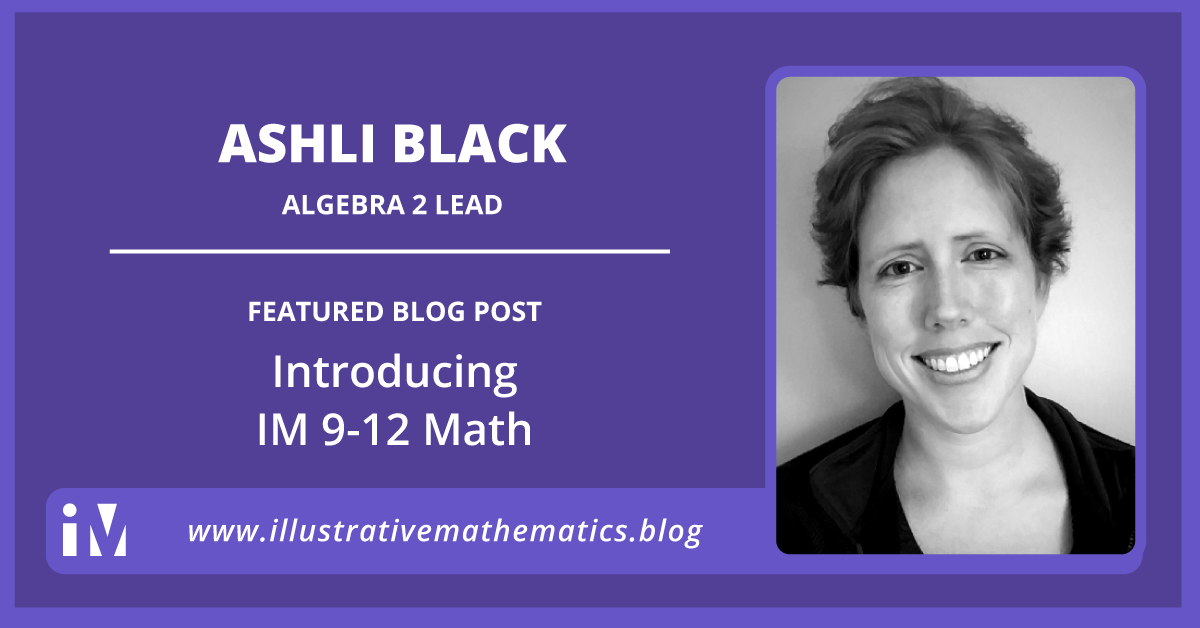IM Algebra 1, Geometry, and Algebra 2 courses are now available to all.
Alright, folks, this is not a drill: IM 9–12 Math is now available to all.
By Ashli Black
So now what? To help folks dive into the curriculum, we’ve put together some links to the curriculum and some relevant blog posts here. No matter what your experience with IM curricula, this post will give you a place to start.
IM offers a standards-aligned, comprehensive curriculum? I thought it was just tasks?
Yes, we do! Back in 2010 we started publishing rigorous, standards-aligned tasks (which are still available), but in order to effect change in the classroom and work toward our mission of a world where learners know, use, and enjoy mathematics, we decided to turn our focus to curriculum writing.
- Our 6–8 Math program was released in 2017, and is top-notch according to EdReports. Learn more about it here. You can preview a demo version of the curriculum, and check out a webinar about the recent enhancements made to the curriculum in time for the 2019–2020 school year.
- Our high school curriculum consists of Algebra 1, Geometry, Algebra 2, and Algebra 1 support materials that are aligned to the curriculum. You can see a demo of it and watch a webinar going over some of the highlights here.
- Our K–5 curriculum is in the works now, and will be available for the 2021–2022 school year. You can sign up here for updates.
I want to dive into the high school courses, but I’m not familiar with IM curriculum—where should I start?
While we know it’s tempting to flip to a favorite topic to see how it plays out, we recommend holding off for a moment to make sense of the intention and underlying structure of the curriculum. Let’s start with a look at the Teacher Guide:

- Start with A Typical IM Lesson to get an idea of how the curriculum is designed in the day-to-day sense. From there, click over to What is a “Problem-Based” Curriculum? for a higher-level view. Those two sections will give you an idea of our underlying beliefs about teaching and learning to help you evaluate whether the curriculum is a good fit for your school.
- Max Ray-Riek is currently putting out a series of blog posts looking at how students perceive problem-based learning. Check out his posts here and here.
I’m familiar with the IM 6–8 curriculum. What are some good entry points for exploring the high school courses?
There are many similarities between the two. For example, they are both problem-based curricula and many of the same people were involved in the writing. If you haven’t already seen it, Kate Nowak wrote this post highlighting features of the high school courses and giving some of the backstory behind it. That said, let’s highlight a few differences:
- Modeling demands at the high school level are greater than those at the middle school level. To meet those demands, a series of Mathematical Modeling Prompts are designed and spaced throughout the units. Depending on time available and what students are ready for, each prompt has multiple versions with different levels of “lift.”
- We know that success in Algebra 1 is crucial to success in future mathematics course work, and that many US high school students struggle to complete Algebra 1 on their first attempt. To help all students succeed in Algebra 1, we’ve written Algebra 1 support materials designed to accompany our Algebra 1 lessons. The support materials include activities to help activate students’ prior knowledge and prepare them for upcoming Algebra 1 lessons. For example, students with a double block or extra math support period can engage in the activities prior to the relevant Algebra 1 lesson. Learn more about these materials in this blog, and then check out the materials here.
I get the big ideas and want more information about the details. What are some decisions that shaped the curriculum?
The Illustrative Mathematics blog is the place to go to get insight from the writing team. Here are a few high school-focused posts to get you started.
- Read more about the thinking behind Rigor in Proofs in the Geometry course.
- We did a lot of thinking about developing conceptual understanding and procedural fluency and how to promote both.
- Distance in the coordinate plane is one example of deemphasizing memorization in favor of sense making.
I’m going to be teaching with this curriculum. Where should I start my planning?
Once you understand the structure of A Typical IM Lesson, here are some other things to check out:
- For many students, the first unit of Algebra 1, Geometry, or Algebra 2 marks their first encounter with an IM curriculum. One key feature of our curriculum is the use of a small set of instructional routines that are used throughout the year. In each of the first units, we included more detailed guidance for how to successfully conduct an instruction routine. You can read more about instruction routines here.
- The first units in each course were carefully chosen to help students shake off summer dust while encountering grade-level mathematics.
- Each unit has a narrative summarizing key points. These are found in the narrative tab of the teacher guide for each course. Here is a link to the unit narratives of Algebra 1.
Next Steps
Now that you’re a little more familiar with what’s coming, watch for the full release over the next several weeks. You can also ask one of our partners about our professional learning options to get a more personalized walk through the materials.
DEMO IM CERTIFIED 9–12 MATH 2020
